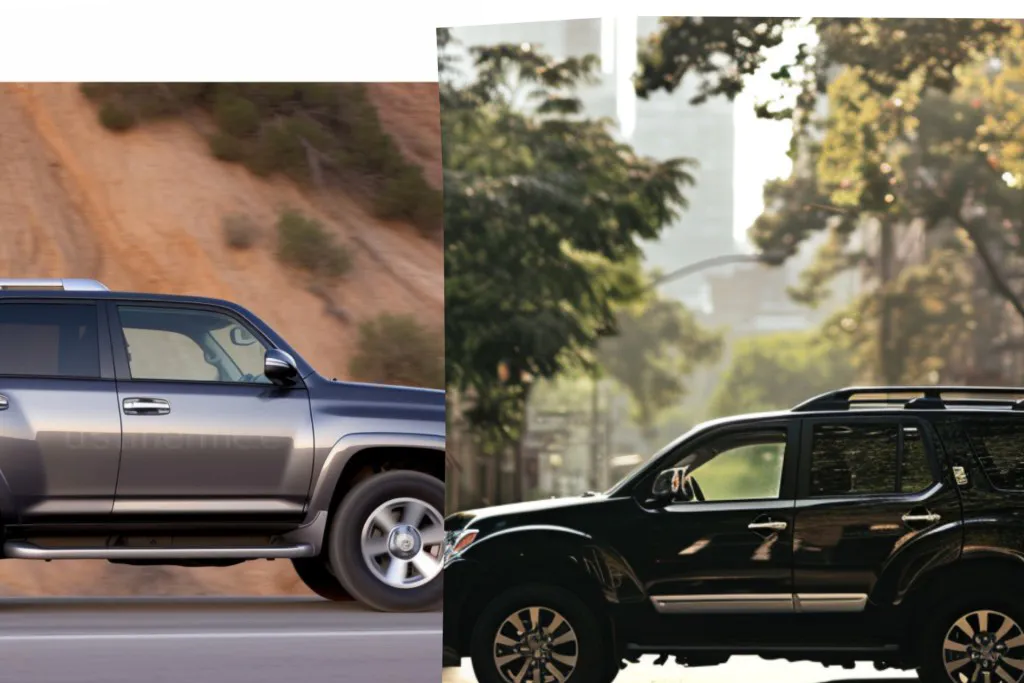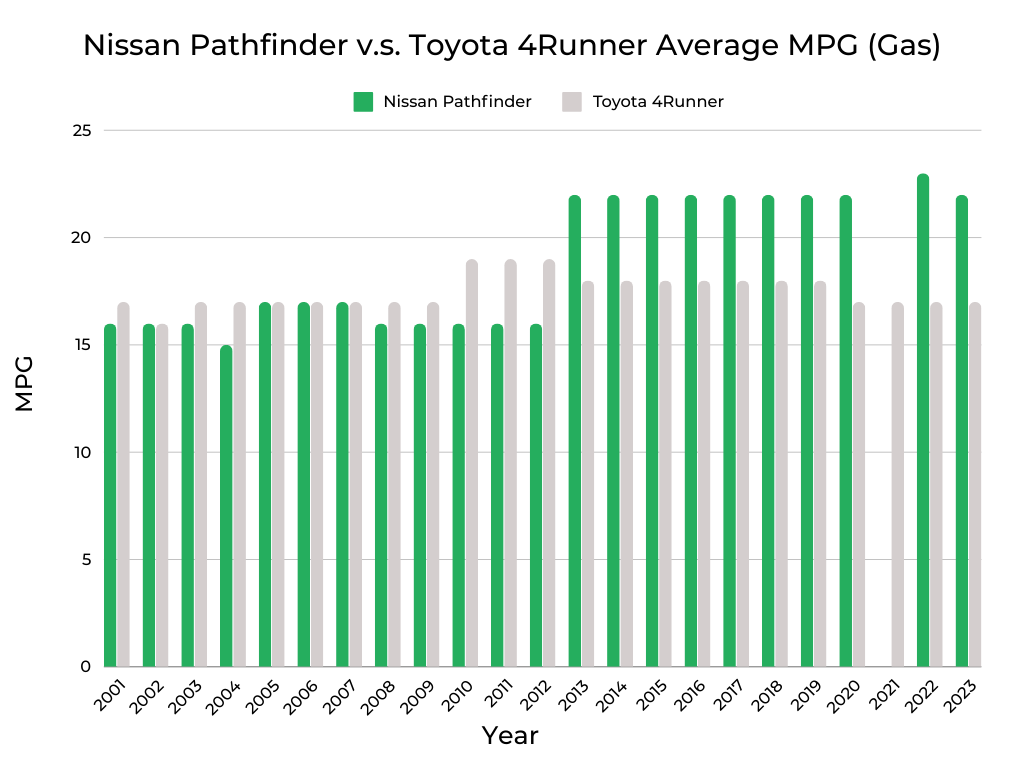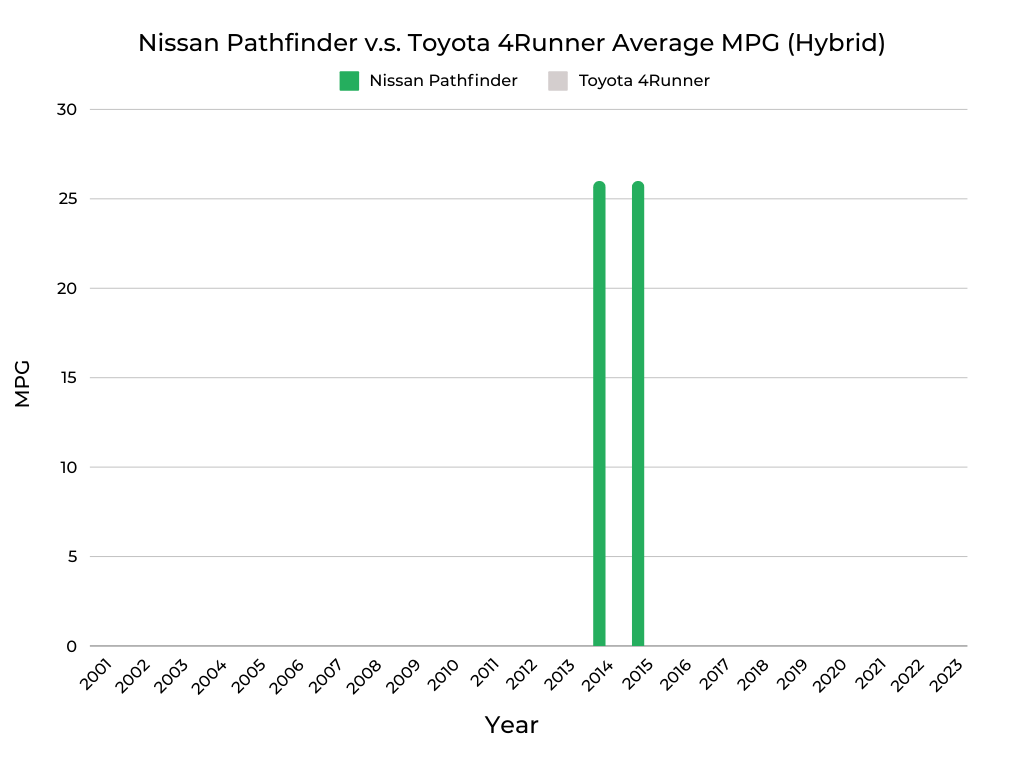In a car market saturated with SUVs, two pioneering vehicles helped launch this trend. The Toyota 4Runner hit U.S. shores in 1984, followed in 1987 by the Nissan Pathfinder, years before anyone heard of a Ford Explorer or Honda CR-V. Borrowing a page from Toyota’s playbook that based the first 4Runner on the Hilux pickup, Nissan adapted the Hardbody truck platform to underpin the initial Pathfinder.
This DNA gave both vehicles off-road capabilities more commonly associated with larger, gas-hungry utilities like the Ford Bronco and Chevrolet Blazer. The trail-friendly Pathfinder and 4Runner continued for decades. However, Nissan deviated from this course by launching a crossover-based Pathfinder for the 2013 model year. Buyers cross-shopping the Pathfinder and the 4Runner need to be aware of this distinction.
The Toyota 4Runner and pre-2013 Pathfinder are body-on-frame SUVs, while more recent Nissan Pathfinders use unibody construction. A body-on-frame vehicle has a separate frame on which the body is mounted, while a unibody vehicle has the frame and body built as a single unit.
Body-on-frame is typically used for trucks and some SUVs for increased durability and towing capacity, while unibody construction is lighter and more common in cars and crossovers for improved fuel efficiency and handling.
In essence, unibody Pathfinders are closer in capability to the Toyota Highlander than the 4Runner. These crossovers (when equipped with all-wheel drive) can handle dirt roads and moderate snow but aren’t up to tackling more rugged terrains.
The Pathfinder’s split personality is the primary reason it doesn’t appear on many shoppers’ radar screens. I can count on one hand the number of crossover-based Pathfinders I’ve encountered, but I regularly see 4Runners in my neighborhood and on the roads.
According to CarFigures, Toyota sold about 110,000 4Runners last year compared to the almost 64,500 Pathfinders sold by Nissan. Keep in mind that the 4Runner has remained unchanged since 2015, while the Pathfinder was all new for 2022.
This popularity gap is equally present in the used car market. Second-hand 4Runners command high prices, even for examples that are 15 to 20 years old. In contrast, used Pathfinders (especially old ones) are bargain opportunities. This disparity is due to the strong residual values for the 4Runner and the lower original prices for the Pathfinder. But don’t assume the 4Runner has lower depreciation because of better reliability. The truth is that the Pathfinder gets good grades for dependability, making specific years of this Nissan a smart buy. Just be aware that Pathfinders are more expensive to maintain and may not have the high mileage capability of a 4Runner.
Arguably, the most significant decision (besides budget) in choosing between the Pathfinder and 4Runner comes down to functionality. Are you looking for a rugged off-roader? Then the 4Runner checks that box, and so does a Pathfinder from before its crossover era. On the other hand, if you like the idea of an SUV but really want a comfortable family cruiser, then the Pathfinder has that covered.
Keep reading to see how this Nissan Pathfinder and Toyota 4Runner contest turns out. You can learn about resale values, depreciation, reliability, longevity, maintenance costs, and fuel economy—essentials to understand to make a more informed car-buying decision.
Other match-ups to review include Tahoe vs Expedition, Suburban vs. Tahoe, Jetta vs. Civic, Sentra vs. Corolla, Outback vs. Forester, 4Runner vs. Highlander, RAV4 vs. CR-V, Civic vs. Corolla, Pilot vs. Highlander, and Odyssey vs. Sienna.
| Income Bracket | Monthly Financing Cost Range | Cash Purchase Price Range | Nissan Pathfinder | Toyota 4Runner | Best Model Year: | Why? |
| $5k-$10k | $83 – $125 | $3,000-$4,500 | 2007 | N/A | 2007 Pathfindeer | Above-average engine reliability, good value |
| $10k-$15k | $125 – $187 | $4,500-$6,750 | 2011 | 2008 | 2011 Pathfinder | Above-average engine reliability, good value |
| $15k-$25k | $187 – $312 | $6,750-$11,250 | 2013 | N/A | 2013 Pathfinder | Above-average engine reliability, good value, and very good safety score |
| $25k-$35k | $312-$437 | $11,250-$15,750 | 2017 | 2012 | 2012 4Runner | Very good engine reliability, good value |
| $35k-$50k | $437-$625 | $15,750-$22,500 | 2019 | 2015 | 2015 4Runner | Very good engine reliability, good value |
| $50k-$74k | $625-$925 | $22,500-$33,300 | 2020 | 2018 | 2020 Pathfinder | Perfect engine reliability, very good safety score, and very good safety score |
| $75k-$99k | $925-$1,238 | $33,300-$44,550 | N/A | 2021 | 2021 4Runner | Perfect engine reliability |
See the methodology for the table above.
Before you respond to the “For Sale” ad, check out this How to Buy a Used Car article for a step-by-step checklist.
Price History Comparison | Nissan Pathfinder vs. Toyota 4Runner
Average Market Value – Based on Owners’ Self-Reported Mileages | Nissan Pathfinder vs. Toyota 4Runner
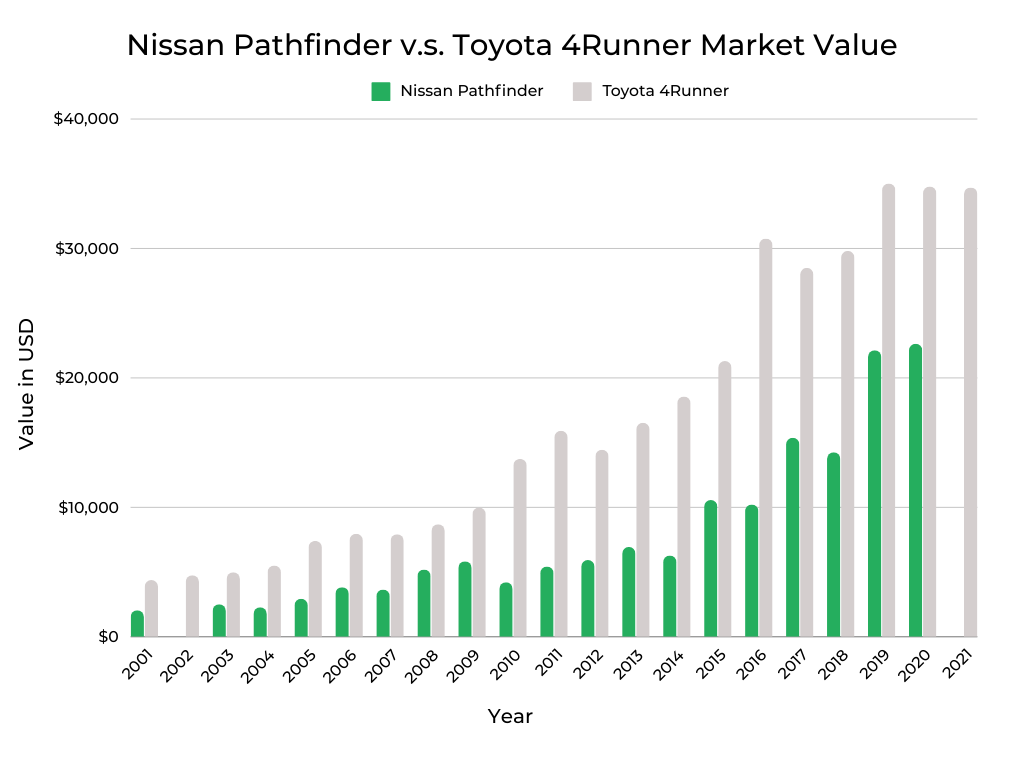
Starting this Nissan versus Toyota showdown with a look at market values highlights the stark contrasts between the Pathfinder (green) and 4Runner (gray). The chart reflects private-party transactions reported by Kelley Blue Book (KBB) and shows that Pathfinders are consistently cheaper as used vehicles than their 4Runner counterparts. In addition, these values have also been adjusted to account for owner-reported mileage from FIXD surveys.
This step helps provide more real-world cost information but also accounts for greater price gaps for specific model years. For example, owners of Pathfinders from 2004, 2005, 2011, 2016, and 2018-2020 drove substantially more than owners of same-year 4Runners, making the Nissans less valuable. Likewise, 4Runners from 2003, 2008, and 2009 racked up significantly more miles, causing their value to drop.
However, no mileage calculation fully explains the difference in valuations for these used SUVs. The answer lies in original selling prices and depreciation.
For example, a base 2007 Pathfinder S sold for $28,250, compared to $30,515 for an entry-level 2007 4Runner SR5. There’s an even more significant disparity among more recent examples. The 2015 Pathfinder S had a $30,680 MSRP against a $35,670 price tag for a 2015 4Runner SR5. So, even before depreciation is applied, the 4Runner starts costing more.
Depreciation further separates these vehicles. That 2007 Pathfinder is now worth about $3,600, while a 2007 4Runner fetches almost $8,000. With a market value of $10,500, the 2015 Pathfinder is half as valuable as a 2015 4Runner.
Newer editions aren’t exempt, either. CarEdge reports that a new Pathfinder loses 31% of its value over five years, while a new 4Runner’s value drops by 19% over the same period.
This all adds to the Nissan Pathfinder being a bargain over the premium-priced Toyota 4Runner.
Remember that these valuations are based on private transactions. Buying at a dealer means paying 30% to 50% more. You can work around higher retail prices by shipping for an older model or one with higher mileage.
Be sure to read our Best and Worst Years series of articles highlighting the Nissan Pathfinder and Toyota 4Runner winners and losers.
Depreciation vs. Maintenance Expenses
Smart used car buyers, like savvy investors, seek vehicles with big price drops from their original cost but low maintenance expenses, essentially “buying the dip” in the used car market.
The buying window for the Pathfinder is small (2010-2014) because these are the only model years where modest upkeep costs and low residual value overlap. That said, these are substantially newer examples to shop for than the “sweet spot” 4Runners.
Low depreciation for these Toyotas means buying opportunities are restricted to the 2002-2006 model years. Shop for a newer 4Runner, and you’ll face greater market values and above-average ownership costs.
But don’t assume every example within these ranges is a smart buy. Learn more by reviewing the best and worst years of the Nissan Pathfinder and Toyota 4Runner. There’s also an at-a-glance summary towards the end of this article.
Reliability Comparison | Nissan Pathfinder vs. Toyota 4Runner
Two ratings are at the core of our look at the Nissan Pathfinder and Toyota 4Runner.
- The FIXD Reliability Score measures the number of check engine lights recorded for a particular model year by installed FIXD sensors. Think of it as an engine reliability score. While every check engine light doesn’t directly translate into reliability concerns (such as a dead battery or loose gas cap), these indicators still provide insight into a car’s dependability. This data is weighted by mileage.
- The second rating is the Owner Reliability Score. This is a subjective ranking of how surveyed owners feel about their respective vehicle’s dependability. Each owner estimates how capable their car is for trips of different lengths. A vehicle that can handle a cross-country adventure receives the highest score, while a car only suitable for a quick point A to point B trip gets the lowest score.
Both rankings are based on 1 being the lowest, 10 being the highest, and 5 being the average score.
We’ll also point out that both scores seldom align. The FIXD Reliability Score is determined by a definitive number, the frequency of check engine lights. On the other hand, the Owner Reliability Score is opinion-based. Owners tend to have pride in their automobiles, with higher ratings as a result. At a minimum, those with older vehicles are more accepting of check engine lights. For many, it’s the price of owning an aging car.
Reliability (or at least perceived reliability) contributes greatly to resale value. Usually, gaps in market values between two vehicles can be explained by notable differences in dependability. This was the case in a recent Ford Escape versus Honda CR-V comparison—Escapes are cheaper for a reason.
But used Pathfinders costing substantially less than equivalent 4Runners can’t be reasoned by lower FIXD Reliability Scores. It’s just the opposite.
Among the 19 analyzed years (there’s no data for the 2002 and 2021 Pathfinders), the Nissan outranked the Toyota for 9 model-year pairs. The 4Runner only came out ahead for 7 years. These SUVs are tied for 3 years.
There’s more evidence in the Nissan’s favor. While there were 7 Pathfinder years with an average FIXD Reliability Score (5 out of 10) or below, the 4Runner had 12 years with subpar results, giving the Pathfinder bonus points for fewer overall check engine lights.
The Toyota 4Runner enjoys cult-like status among its ownership community; it has a following similar to that of a Jeep Wrangler. This dedication is shown in the solid owner reliability scores. Despite an abundance of check engine lights, no 4Runner was ranked below an 8 for reliability by an owner.
The same can’t be said of the Pathfinder. Even with strong engine reliability, owners of these Nissans are less favorable towards their rides. However, this less positive feedback focused more on older model years, which is understandable; few vehicles with 15-20 years of use are perfect.
Review the Best and Worst Years articles on the Nissan Pathfinder and Toyota 4Runner to learn more about these vehicles’ FIXD Reliability and Owner Reliability Scores.
Longevity Comparison | Nissan Pathfinder vs. Toyota 4Runner
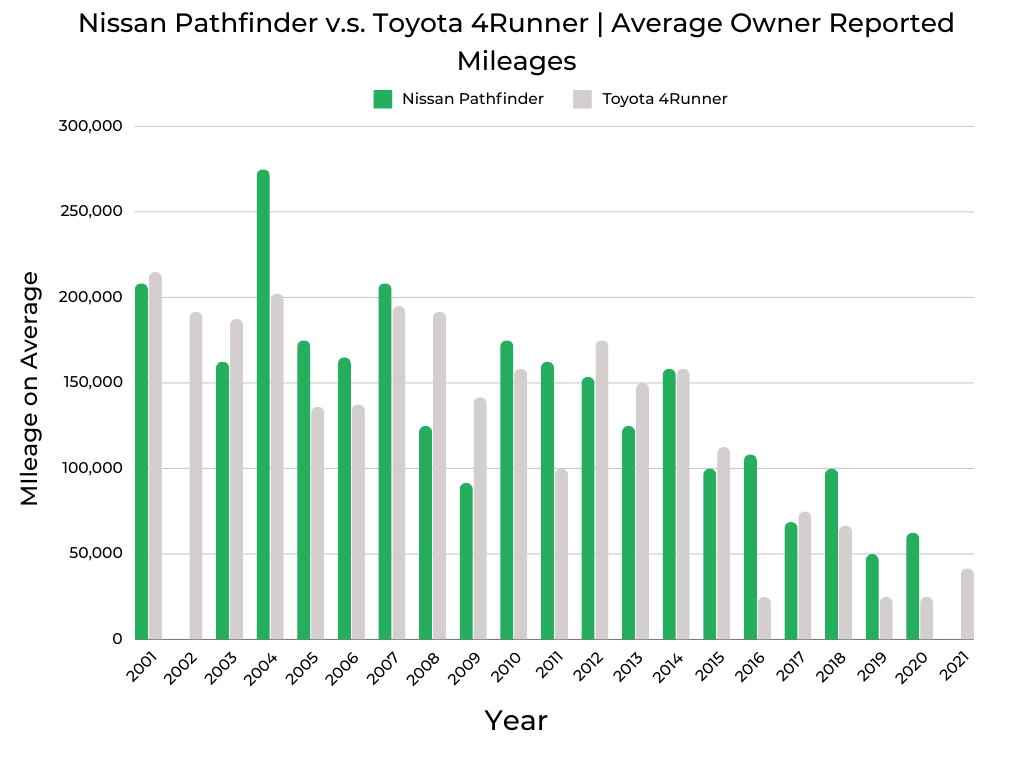
FIXD owner surveys reveal that the Pathfinder and 4Runner can reach 150,000-200,000 miles equally. At the same time, Nissan can claim bragging rights for the class overachiever, the 2004 model year with an average of 275,000 miles.
An unscientific review of online listings provides additional insights into the longevity of the Pathfinder and 4Runner. Marketplace autotrader.com (as of March 19, 2024) has 231 Pathfinders and 916 4Runners for sale. All are from the 2001-2012 model years, examples that typically have higher mileage. The quantity differences are unsurprising, as the 4Runner is substantially more popular.
Among these listings, 88 (38.1%) Pathfinders and 341 (37.2%) 4Runners have 150,000-200,000 miles. These near-identical percentages are consistent with the assumption that either SUV can reach 200,000 miles. Adding both vehicles to your shopping list is fine if this is your mileage goal.
However, the numbers tell a different story once high mileage becomes a factor. There are 36 Pathfinders (15.6%) and 292 (31.9%) 4Runners for sale with 200,000 miles or more. These percentages indicate that the 4Runner is twice as likely to crossover into “well-used” territory.
Of course, this doesn’t mean every Pathfinder is headed to the junkyard after the odometer rolls over to 200,000 miles. Well-maintained examples that haven’t been abused are likely to keep on going (the same applies to high-mileage 4Runners).
For a more thorough look at longevity, review the individual articles on the best and worst years of the Nissan Pathfinder and Toyota 4Runner.
Who Should Buy These Cars: The Legacy of Nissan Pathfinder vs. Toyota 4Runner
People buy SUVs for a reason: to haul people. This usage is confirmed by the FIXD surveys reporting that 40% of Pathfinder owners use their vehicles to transport loved ones. It’s 37% among the 4Runner crowd.
Activities that fall under the “lots of driving” category (commuting and road trips) are also frequent for these vehicles. However, at 33%, the Pathfinder sees slightly more action in this area than the 4Runner (at 27%). The smooth-riding characteristics of the unibody Pathfinder generations account for this difference.
At the same time, 18% of 4Runner owners use their SUVs for outdoor and off-road purposes, compared to 8% of Pathfinder owners. Here, the never-changing body-on-frame characteristics of the 4Runner explain the gap.
| Frequent Use Categories: | Nissan Pathfinder | How Useful? (Out of 5 Stars) |
Toyota 4Runner | How Useful? (Out of 5 Stars) |
| Family Vehicle | * * * * | * * * * |
| Lots of Driving (travel/long commute) |
* * * * | * * * |
| Hauling/Towing | * | * |
| Office on Wheels | * | * |
| Sport/Fast Driving | * | * |
| Luxurious Driving | * | * |
| Outdoor/Off-Road | * | * * |
Driver Experience | A Summary of The Top 10 Nissan Pathfinder vs. Toyota 4Runner Posts:
Reddit discussions comparing the Nissan Pathfinder and Toyota 4Runner provide valuable insights for potential buyers. Here are highlights from popular threads on Reddit: r/whatcarshouldIbuy.
Reliability
Reliability is a key focus in discussions about the Nissan Pathfinder and Toyota 4Runner. Commenters note the Pathfinder’s switch to a CVT transmission, hinting at uncertain reliability. One Redditor mentioned, “Nissan made and still makes extremely reliable cars, their only drawback is the [deleted] CVT,” suggesting the Pathfinder has the potential for long-term dependability. The 4Runner, on the other hand, is praised for its proven reliability, with one user highlighting Toyota’s reputation for durability and the fact that their family’s Toyotas have never needed significant repairs.
Comfort and Functionality
The Pathfinder is commended for its passenger and cargo space, making it suitable for families and hauling materials. Its modern tech features, like Android Auto and heated seats, are also highlighted. The 4Runner, while older in tech, is appreciated for its cargo space and unique features like the rear window that rolls down, aiding in transporting large items.
Performance and Value
Performance-wise, the Pathfinder is noted for better gas mileage and a more contemporary feel than the 4Runner. However, the 4Runner’s off-road capability and robustness are points of consideration. Regarding value, the Pathfinder offers more features for a similar price point, but the 4Runner’s longevity and resale value are significant factors.
Reddit Recap
Reddit users compare the Nissan Pathfinder and Toyota 4Runner primarily on reliability, comfort, functionality, and value. The Pathfinder is considered a more modern and fuel-efficient option with ample space for passengers and cargo. At the same time, the 4Runner is lauded for its durability, off-road prowess, and resale value. The choice between the two hinges on the balance between modern features and proven reliability.
Year-by-Year Comparison | Nissan Pathfinder vs. Toyota 4Runner
Best & Worst Years | Nissan Pathfinder vs. Toyota 4Runner | 2001-2024

Shoppers focusing on the bottom line over the brand have one choice: the 2007 Pathfinder. It’s cheaper than the oldest “green light” 4Runners from 2003-2004 and far less expensive than 2007-2008 4Runners.
Otherwise, the 2010-2021 model years of the Pathfinder present numerous opportunities to find a used SUV at the right price and condition. If one group of used Pathfinders says “buy me,” it’s the 2010-2012 editions, the last of the body-on-frame years. They’re well below $10,000 (on the private market), enjoy above-average engine reliability, and combine high depreciation with modest upkeep costs. It’s a value that’s hard to pass up. Importantly, any used car should undergo a thorough pre-purchase inspection before money changes hands.
Those with a 4Runner mindset have many to choose from, as the 2012-2015, 2017-2018, and 2020-21 model years all pass muster, just at higher prices.
I’ll call attention to the undecided years (yellow) only because there isn’t enough information to give these editions a thumbs-up or thumbs-down.
Important Features Timeline | Nissan Pathfinder vs. Toyota 4Runner

The rollout of features for the Pathfinder and 4Runner reflects each automaker’s approach to SUVs. The Pathfinder blurred many lines as older models sought to be both family-friendly haulers and off-road adventures. In addition, Nissan regularly introduces new Pathfinder generations.
As a result, the Pathfinder came with comforts like heated front seats, ventilated front seats, and a driver’s memory system before the 4Runner. Blind-spot monitoring and parking sensors also landed first on the Pathfinder.
Meanwhile, thanks to other SUVs in its lineup (namely the Highlander), Toyota didn’t have to worry about multiple missions for the 4Runner. Sure, it offered three rows, but this vehicle has always been about off-pavement capability. Further, Toyota’s if-it-ain’t-broke-don’t fix-it mentality with the 4Runner meant this vehicle hasn’t seen a new generation since 2010 (a new 4Runner is coming for the 2025 model year).
The 4Runner’s claim to fame for equipment firsts—lane departure warning, a rearview monitor, and remote start—didn’t require massive engineering efforts. Toyota also didn’t wait for a new generation to introduce Apple CarPlay and Android Auto, while Nissan didn’t add this until the fifth-gen Pathfinder arrived for 2022.
Maintenance Costs (Year-by-Year Average) | Nissan Pathfinder vs. Toyota 4Runner
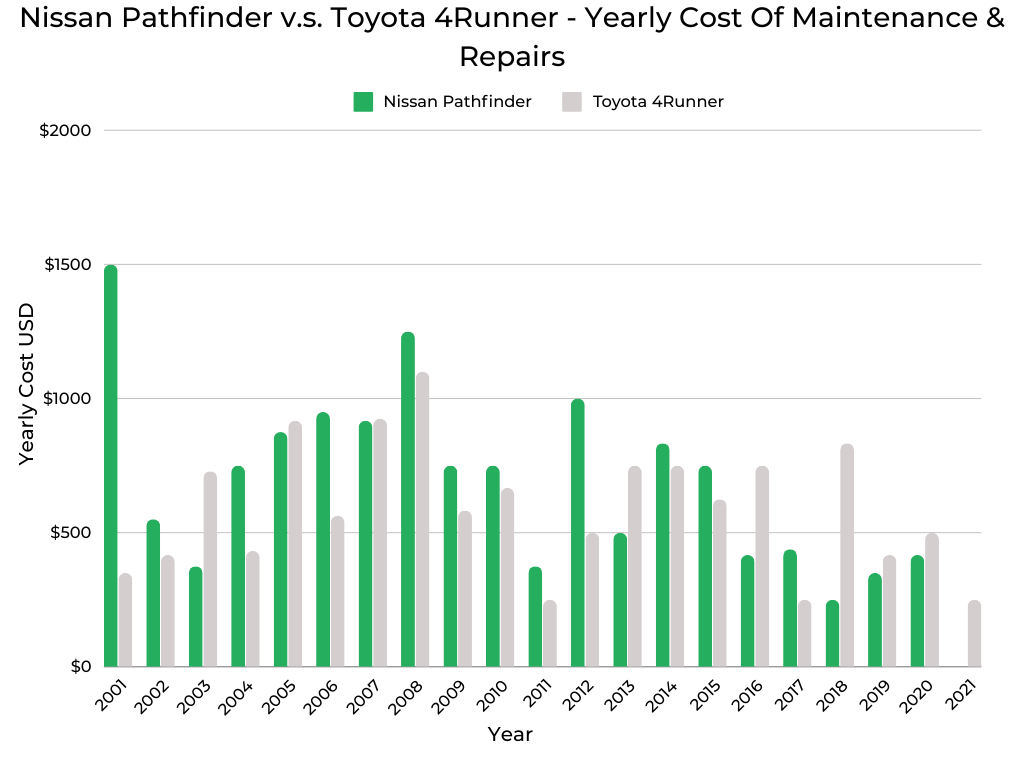
One downside to buying a used Pathfinder is higher outlays for repairs and maintenance. According to FIXD surveys, Nissan owners spent an average of $708 to keep their vehicles in operating condition. That’s about 18% more than their 4Runner peers, whose similar expenses average $598.
Some model years were worse than others, with Pathfinders from 2001, 2005-2008, and 2012 having repair bills at least 20% above the $708 average. In particular, the 2001 Pathfinder was especially expensive as numerous owners reported engine and transmission work, usually the most costly repairs.
However, 4Runner owners aren’t totally in the clear. There are more model years (2003, 2005, 2007, 2008, 2013, 2014, 2016, and 2018) for this Toyota with above-average maintenance costs (20% or more above the $598 average) than with the Pathfinder.
Review the best and worst years of the Nissan Pathfinder and Toyota 4Runner to learn more about maintenance and repair costs for these vehicles.
Safety Rating Comparison | Nissan Pathfinder vs. Toyota 4Runner
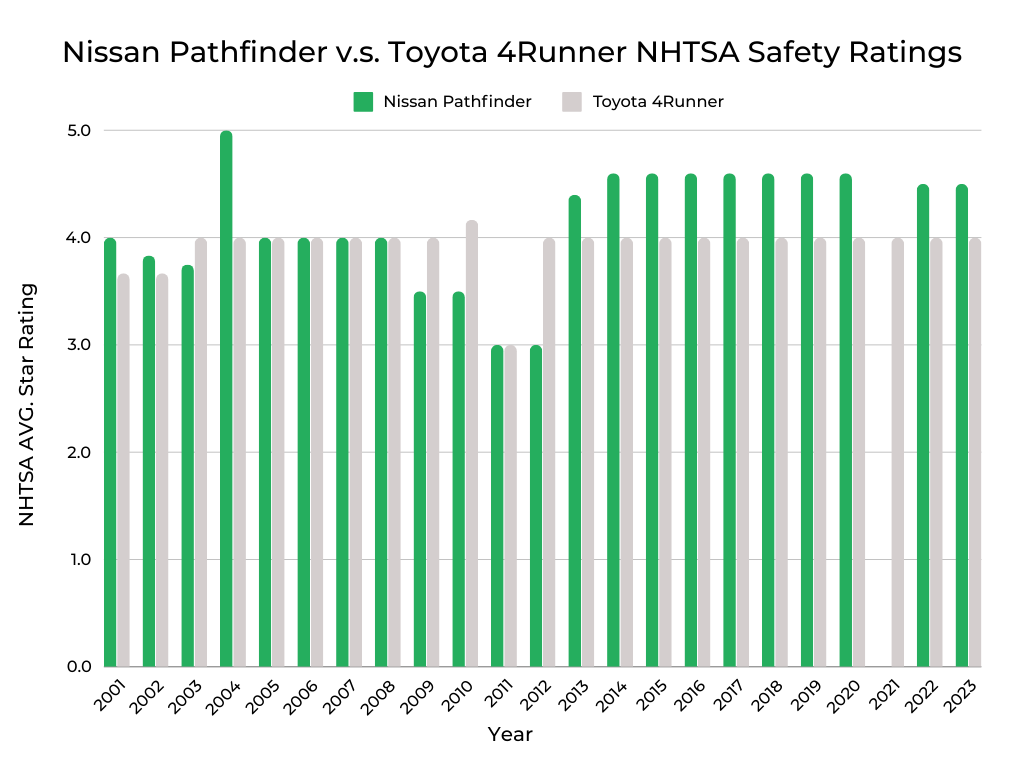
While not always the case, unibody vehicles tend to perform better in safety tests thanks to a structure designed to redistribute crash energy. This is obvious with the most recent Nissan Pathfinder generations (remember, the Pathfinder switched to a unibody platform for 2013), a clear improvement over the earlier years.
The more stringent testing standards imposed by the National Highway Traffic Safety Administration (NHTSA) for the 2011 model year make Pathfinder’s safety improvements especially significant. Not only did the 2013-2023 Pathfinders outperform their predecessors, but they did so under more vigilant evaluations.
The 2011-2012 Pathfinders are in somewhat of a limbo situation. They would have performed well under the old procedures (the 2010 model scored a good 4.0 out of 5) but rated a subpar 3.0 under the new guidelines.
The new NHTSA requirements also caused poor test results for the 2011 4Runner. However, Toyota engineered a remedy with the 2012 4Runner bouncing to an acceptable score. Overall, however, the 4Runner consistently does better in NHTSA evaluations until the 2019 model year.
More details about crash test safety scores are covered in the Nissan Pathfinder and Toyota 4Runner articles.
Fuel Efficiency Comparison | Nissan Pathfinder vs. Toyota 4Runner
Large and lumbering SUVs aren’t known for sipping fuel, and the older Pathfinders and 4Runners prove this point with fuel economy that hovers around 15 MPG. The 4Runner became more efficient after the discontinuation of the V8 engine in 2009.
Fuel economy zooms with the arrival of the fourth-generation Pathfinder for 2013. Not only did Nissan drop the V8 and save weight, but it also switched to an MPG-friendly continuously variable transmission (CVT).
Gas efficiency is essentially a wash between both models sold before 2013. But the Pathfinder gains the upper hand after. It’s 20%-30% better MPGs than the 4Runner and can add substantial savings over time.
Nissan’s effort with the hybrid Pathfinder deserves an honorable mention, but it underwhelmed buyers. A modest gain in fuel economy didn’t offset the extra cost, and the four-cylinder hybrid system was underpowered compared to the six-cylinder hybrid setup available in the Toyota Highlander hybrid at the time.
Methodology
- Compare two vehicles, the Nissan Pathfinder and Toyota 4Runner, and provide a comprehensive analysis.
- Gather relevant information and data on both vehicles from reliable sources, such as manufacturer specifications, expert reviews, customer feedback, industry reports, and data sources like manufacturer websites, FIXD App, Kelley Blue Book, FuelEconomy.gov, and NHTSA.
- Collect data on various aspects, including performance, safety features, fuel efficiency, maintenance costs, reliability, owner satisfaction, and market value.
- Identify the key criteria that will be used to evaluate and compare the two vehicles.
- Ensure the criteria cover both objective factors (such as performance metrics, safety ratings, and fuel efficiency) and subjective factors (such as owner satisfaction, comfort, and features).
- Examine the safety features and ratings of both vehicles.
- Evaluate crash test ratings, advanced driver assistance systems (ADAS), active and passive safety features, and any notable recalls or known issues related to safety.
- Consider both NHTSA safety ratings and IIHS awards for a comprehensive safety assessment.
- Analyze the fuel economy of both vehicles based on EPA mileage estimates.
- Compare their MPG ratings, average full-tank range, and any significant differences in fuel efficiency.
- Assess the average annual maintenance and repair costs for both vehicles.
- Consider data from surveyed owners and other reliable sources, such as FIXD App owner surveys, to determine the overall cost of ownership over time.
- Evaluate the reliability of both vehicles based on owner reports, FIXD App data, and any known issues or recalls.
- Consider factors such as engine reliability, common problems by model year, long-term durability, and owner reliability scores gathered from surveys.
- Consider owner satisfaction by gathering information from forums, online communities (Reddit: r/whatcarshouldIbuy), customer reviews, and owner reliability scores.
- Summarize key factors that owners appreciate and any common complaints or drawbacks mentioned by owners.
- Compare the features and technologies offered by both vehicles.
- Highlight any notable differences in terms of infotainment systems, connectivity options, driver assistance features, interior quality, and available upgrades.
- Assess the market value and depreciation of both vehicles.
- Compare average prices, resale value, and how the vehicles hold their value over time.
- Consider average private-seller valuations from Kelley Blue Book (KBB) for a comprehensive assessment.
- Summarize the findings of the comparison, highlighting the positives and negatives of each vehicle.
- Provide a fair and balanced recommendation based on the comparison, considering factors such as budget, personal preferences, specific needs of the buyer, and the comprehensive analysis conducted.
Sources:
- KBB Values: Average private-seller valuations as supplied by Kelley Blue Book (KBB), based on a Nissan Pathfinder and Toyota 4Runner, with typical mileage for that respective model year.
- Fuel Economy: Mileage-per-gallon estimates according to the EPA MPG on Fueleconomy.gov.
- Annual Maintenance/Repairs: Upkeep expenses as reported by surveyed Nissan Pathfinder and Toyota 4Runner owners.
- Safety Ratings: Crash test data collected and reported by NHTSA. We average all ratings for each year to come up with a simplified, average safety score. This makes it easier to look at on a graph. We also collected IIHS Awards for this article.

Dave Goldberg is an automotive journalist and lifelong car fanatic. He writes for numerous enthusiast and business outlets and is an ongoing contributor to HotCars.com, one of the most popular car culture websites. When he’s not writing or driving, Dave is either under a hood or asleep. His credentials include a BA in Journalism from The George Washington University.

